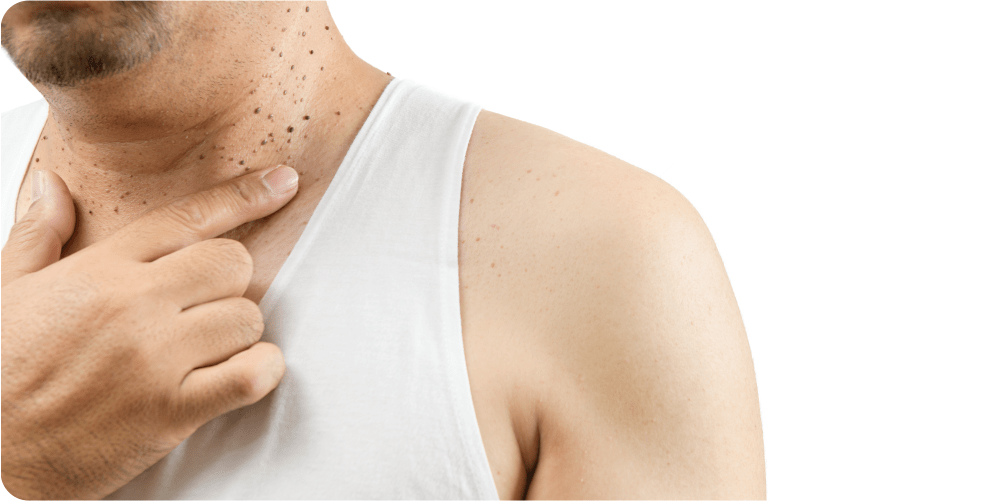
What are Moles?
Most moles are benign skin growths that are common. On your body and face, you most likely have more than one. Moles can range in colour from your original skin tone to pink, brown, or black, and they frequently arise in your childhood or teen years. Darker hair and skin are more likely to have darker moles than lighter hair and skin. Moles on your skin can be either flat or elevated. Some moles develop gradually and may become lighter or vanish with time.
Why is a Mole removed?
Atypical moles on your face, neck, arms, legs, or chest are treated with mole removal. You don’t need to get a mole removed unless it’s cancerous. The mole can still be removed if you don’t like how it makes you look or if it’s irritating you because it’s rubbing against your clothing. You can have stinging or burning in the area for a few days following the surgery.
How can I tell whether a mole is cancerous?
Read MoreWhat are Moles?
Most moles are benign skin growths that are common. On your body and face, you most likely have more than one. Moles can range in colour from your original skin tone to pink, brown, or black, and they frequently arise in your childhood or teen years. Darker hair and skin are more likely to have darker moles than lighter hair and skin. Moles on your skin can be either flat or elevated. Some moles develop gradually and may become lighter or vanish with time.
Why is a Mole removed?
Atypical moles on your face, neck, arms, legs, or chest are treated with mole removal. You don’t need to get a mole removed unless it’s cancerous. The mole can still be removed if you don’t like how it makes you look or if it’s irritating you because it’s rubbing against your clothing. You can have stinging or burning in the area for a few days following the surgery.
How can I tell whether a mole is cancerous?
A dermatologist visit for an annual skin cancer screening is the best technique to determine whether a mole is malignant. Your physician will submit the sample to a lab for additional examination. It’s known as a biopsy. The entire mole and surrounding area must be removed to get rid of the hazardous cells if the test results are positive, indicating that the mole is malignant. Your dermatologist might advise more frequent screening if you’ve had skin cancer in the past.
In the interim, you should make an appointment with your dermatologist for a checkup if you see any moles that:
- Are evolving or changing in size, shape, or colour
- Are asymmetrical; have uneven borders
- Are not uniform in colour
- Have a diameter greater than the diameter of a pencil eraser
- These are referred to as the mole checks’ ABCDEs
A dermatologist should examine these moles to see whether they need to be examined for skin cancer.
What should I think about before having my mole removed?
A scar will result from surgically removing a mole, whether it is done for aesthetic purposes or because the mole is cancerous. The resulting scar, however, may almost go away on its own depending on things like:
- Your age
- The procedure
- The mole’s location
It can be next to impossible for you to identify the precise location of the operation. Or, the scar that results can be more obvious than you’d prefer.
You can experiment with a range of products and techniques to lessen a mole removal scar. First, it can be beneficial to have a basic understanding of how moles are removed and how the typical healing process works.
What is the process?
The two primary techniques for removing moles are surgical excision and shave excision. Both methods of mole removal have advantages and disadvantages, just like any medical operation. Your dermatologist can advise you on the best course of action.
Freezing. A noncancerous mole is removed using a little amount of liquid nitrogen in this operation.
Burning. An electric current is used in this operation to burn off the top layers of a noncancerous mole. The excision of the mole can require more than one session.
Shaving. The mole will be removed off the skin’s surface with a surgical blade in this process.
Excision. In order to completely remove the mole and repair the skin, this process goes further than simple shaving. If the mole is malignant, this kind of removal is frequently employed.
Your dermatologist can check the mole that was removed for skin cancer if necessary.
Why is removal of a mole at home harmful?
Home mole eradication techniques sound rather simple and practical. One of these methods can encourage you to attempt it instead of visiting your dermatologist’s clinic. However, there is no proof that home remedies for mole removal are effective, and some of them might even be harmful.
Several studies
Mole removal creams sold in pharmacies and online retailers have been linked to negative side effects, according to a reliable source. These creams have the potential to leave the mole area with significant scarring.
There are dangers involved when moles are removed by being cut off with a sharp instrument like scissors or a razor blade. Your risk of contracting an infection increases when you cut off any growth, particularly if the item you use has not been thoroughly cleaned. You could also leave a lasting scar in the spot where the mole existed.
You can’t know if a mole is cancerous if you remove it yourself, which is another risk. Melanoma could appear as a mole. If the mole is cancerous and you don’t have a dermatologist test it, it could spread throughout your body and endanger your life.
What Are the Home Remedies and Home Care Treatments Following Mole Removal?
Home care
- Following the procedure, the wound must be covered with a bandage and a layer of petrolatum (Vaseline).
- Once or twice a day, wash the wound with water or diluted hydrogen peroxide.
- Apply petrolatum and a bandage after cleansing the wound.
Until the wound has healed, these actions are repeated.
Erroneous beliefs about healing
Some individuals believe that exposing wounds to the air promotes healing. This has been debunked by numerous studies, which also revealed that bandages and antimicrobial salves considerably speed up healing. Similar to how vitamin E has been shown to slow healing rather than speed it, vitamin E applied directly to wounds may result in worse scarring than it would otherwise.
Recovery period following mole removal
The length of recovery following mole removal varies every person. Younger persons typically heal more quickly than older adults. Naturally, a larger incision will require more time to heal than a smaller one. A mole removal scar will typically take at least two to three weeks to heal.
With Epicure on your side, you don’t need to worry about your mole removal surgery. To give you the greatest care at the most affordable price, we collaborate with the best medical specialists!
FAQs
Most moles don’t require treatment. But you might want to have a mole removed if you’re unhappy with how it looks or feels. Talk with your healthcare provider if you’re concerned about a mole. Generally, moles are removed if your provider suspects they might be cancerous or for cosmetic reasons.
Healing time depends on your overall health and the size of the mole you had removed. It’ll likely take two to three weeks to heal from mole removal. During this time, you’ll be able to do your daily activities, but may have a little soreness. To promote healing and prevent infection, you should follow your healthcare provider’s instructions about wound care.
Following mole removal, you’ll have a wound that you should keep clean, moist and covered. Be sure to change the dressing daily or as instructed by your healthcare provider. After you’ve healed, be sure to apply sunscreen to the area when it’s exposed.
The risks associated with various mole removal techniques range from infection to very uncommon anaesthetic allergy and nerve damage. Always choose a dermatologist or surgeon with the necessary training and working knowledge for these removals. As a result, the procedure's dangers will be reduced.
The other dangers change according to the treatment area and removal technique.
A scar is among the most typical issues that arise following mole removal. Unaware that every mole excision will leave a scar, many people will attempt to remove moles for cosmetic reasons. Before you decide whether to have the mole removed, the surgeon will frequently be able to give you an idea of the sort of scar that may result.



